
Contact
Biological mapping
Børge Holte
+47 77 60 97 53
Geological mapping
Terje Thorsnes
+47 73 90 42 75
Bathymetry
Hanne
Hodnesdal
+47 51 85 88 23
Information officer
Beate Hoddevik Sunnset
+47 55 23 85 16

Published: 24.11.2009 Updated: 24.10.2019
Blue holothurians (sea cucumbers) amongst sea lilies together with brilliantly red shrimps and irregular sea urchins were just some of the astonishing creatures that scientists observed when they earlier this autumn they explored the sea bottom down to 2700 metres depths in Nordland VII, an area off the coast of Northern Norway.
By Beate Hoddevik Sunnset
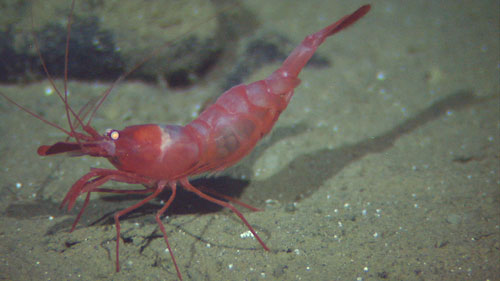
The colourful Bythocaris leucopis shrimp is common down to
depths of 2700 metres.
This is the deepest survey that has been conducted as part of the MAREANO mapping programme. At these depths, it is permanently dark, and thewith temperatures is between -0.5 and -1.1 degrees C. The high pressure at these depths together with the long distance between boat and seafloor makes it highly challenging for the performance of sampling and video equipment.
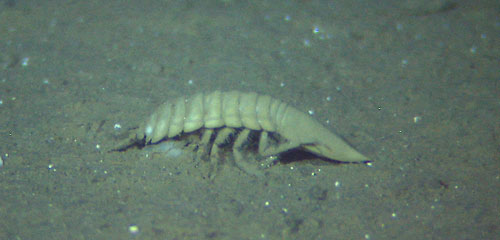
The large isopod Saduria (5 cm long) is also
common.
In comparison to shallower areas, the fauna becomes increasingly sparse and unusual at depths greater than 2000 metres. However, scientists observed an Arctic fauna that appears to be common to the deep parts of the North Atlantic and the Norwegian Sea basin. The number of benthic species is low in this cold and homogenous environment, which mainly consists of a greyish-brown sandy silt with occasional boulders, is few. However, some organisms are more common and species rich at these depths than in shallower areas, such as glass sponges and holothurians.
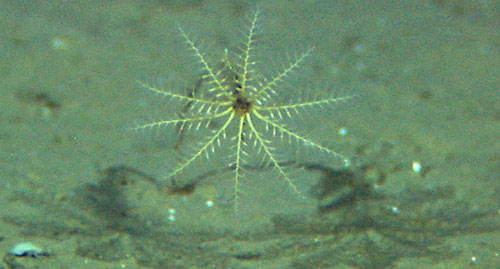
The sea lily Rhizocrinus lofotensis was observed in dense
stands in the areas surveyed bellow 2000 m. This specimen is
approx. 10 cm high.
The most common large organisms at depths greater than 2000 metres are sea lilies (which are stalked crinoids) and two species of holothurians. The sea lily (Rhizocrinus lofotensis) grows in dense forests resembling little palm trees (7-10 cm high) on the sea bottom, with holothurians walking very slowly between them. The two common holothurians belong to the species Elpidia sp. (small and greyish) and Kolga hyalina (the bigger blue). All three species are typical of the deep parts of the Norwegian Sea, however, Elpidia sp. can also be found in shallow cold waters.

The blue holothurians (sea cucumber) Kolga hyalina
(approx. 5 cm long) is a prominent species at 2700 m in the
Norwegian Sea.

The grey holothurians Elpidia sp. (approx. 1.5 cm long)
is very common in the deep parts of the Norwegian Sea, but can also
be found in shallower waters.
At approx. 2100 metres below sea level we found geological structures and bacterial films on rocks that are indicative of gas seeps. In the same area large caves were observed (30-40 cm in diameter) with unknown origin. At present it is not clear whether they are created by biological or geological processes. An unidentified, 40 cm-long organism was observed several times by video. This organism has many resemblances to a strange group of snake like hydrozoans belonging to the genus Candelabrum. These hydroids that are long, furry looking and thin can contract their body, unlike most other hydroids. The observed specimens are very much larger compared tothan earlier describesd species in this group.
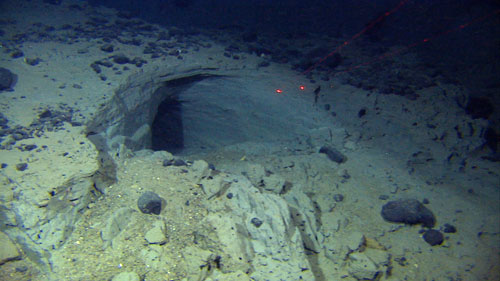
Large caves, or "tunnels", were observed, up to 30-40 cm in
diameter. It is unclear how they are formed.
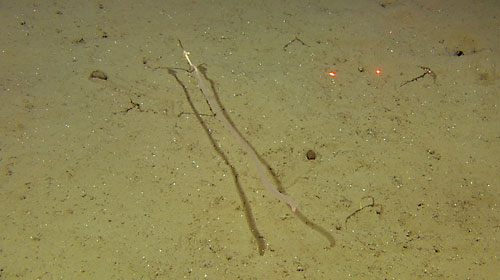
A long (approx. 40 cm-long) snake like and pink organism was
recorded several times at depths of 1500-2000 metres. This organism
is likely new to Norwegian waters and has many resemblances to the
strange group of hydroids belonging to the genus
Candelabrum.
This year, the 6th and 7th MAREANO expeditions with the research vessel G.O. Sars were completed, with Nordland VII being one of the areas surveyed as part of the autumn expedition. During the expeditions, the sea bottom was filmed, and samples were taken to document the seabed types, benthic fauna and levels of environmental contaminants. Any traces of human activities such as fisheries were also documented. This year 129 locations were visited, with 132 video transects being taken and 26 sampling stations being established.

Map showing the position of localities that was visited in
Nordland VII.